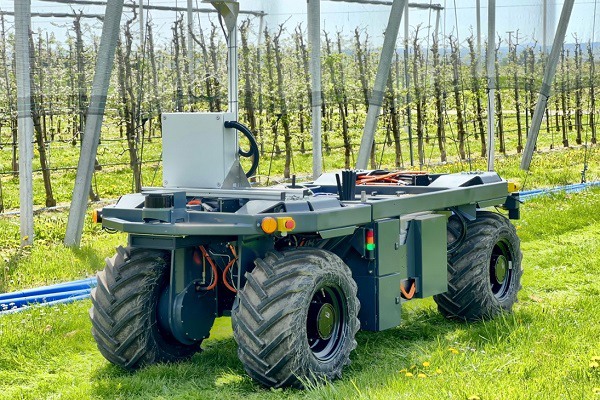The ELWOBOT, an autonomously driving fruit and wine-growing robot with a modular energy supply and electric drive, is now entering the test phase after less than three years of planning and construction. This was announced today in Dresden by the Saxon State Office for the Environment, Agriculture and Geology (LfULG).
For this purpose, the Technical University of Dresden and the Fraunhofer Institute for Transportation and Infrastructure Systems IVI have installed a small mobile 5G transmitter unit on the LfULG's test fields in Dresden-Pillnitz. In an apple orchard, all work steps that the ELWOBOT will take over in the future will be tested until spring 2024. For example, tests are being conducted to determine how the use of pesticides can be reduced to the absolutely necessary level by scanning the treetops with a LiDAR sensor that determines the condition of the foliage. In addition, the sensor will continuously check the leaf growth of the trees and thus provide information on the condition of the nutrient supply. Tests will also be conducted to determine how well the ELWOBOT can perform maintenance tasks such as tilling the area under the trees and mowing and mulching the tramlines.
 The ELWOBOT on the LfULG test plots in Pillnitz. (© LfULG/ Hofer)
The ELWOBOT on the LfULG test plots in Pillnitz. (© LfULG/ Hofer)
The robot is to drive fully autonomously, both on planned and learned routes. This includes, for example, driving the ELWOBOT autonomously to the Agri-PV test facility of the HTW Dresden on the Pillnitz experimental plots to recharge the battery. Maximum safety for people and the environment is ensured by 2D and 3D laser sensors, which are designed to provide orientation and navigation in the plantation and detect obstacles.
To ensure the processing of the large amounts of data generated in the process and to adapt the crop protection module to the tree structure in real time, the data is sent to a central computer using 5G technology, processed and the adapted control commands are sent back.
The power and orientation of the 5G antenna are limited to the ELWOBOT's action area on the approximately nine-hectare test field in Pillnitz. This is intended to save energy and not interfere with other radio sources such as Wi-Fi, cell phones, CB radio or radios. How well this works in practice is also being tested in the project. To further optimize energy consumption, the test field will only be activated for measurements of the transmission power in changing vegetation or for test drives of the ELWOBOT.
The ELWOBOT is a joint research project of the TU Dresden and the LfULG. The costs totaling around 1.8 million euros are being covered by the state of Saxony. In the summer of 2024, the ELWOBOT should be ready as a pre-series model.
Further information: www.medienservice.sachsen.de
